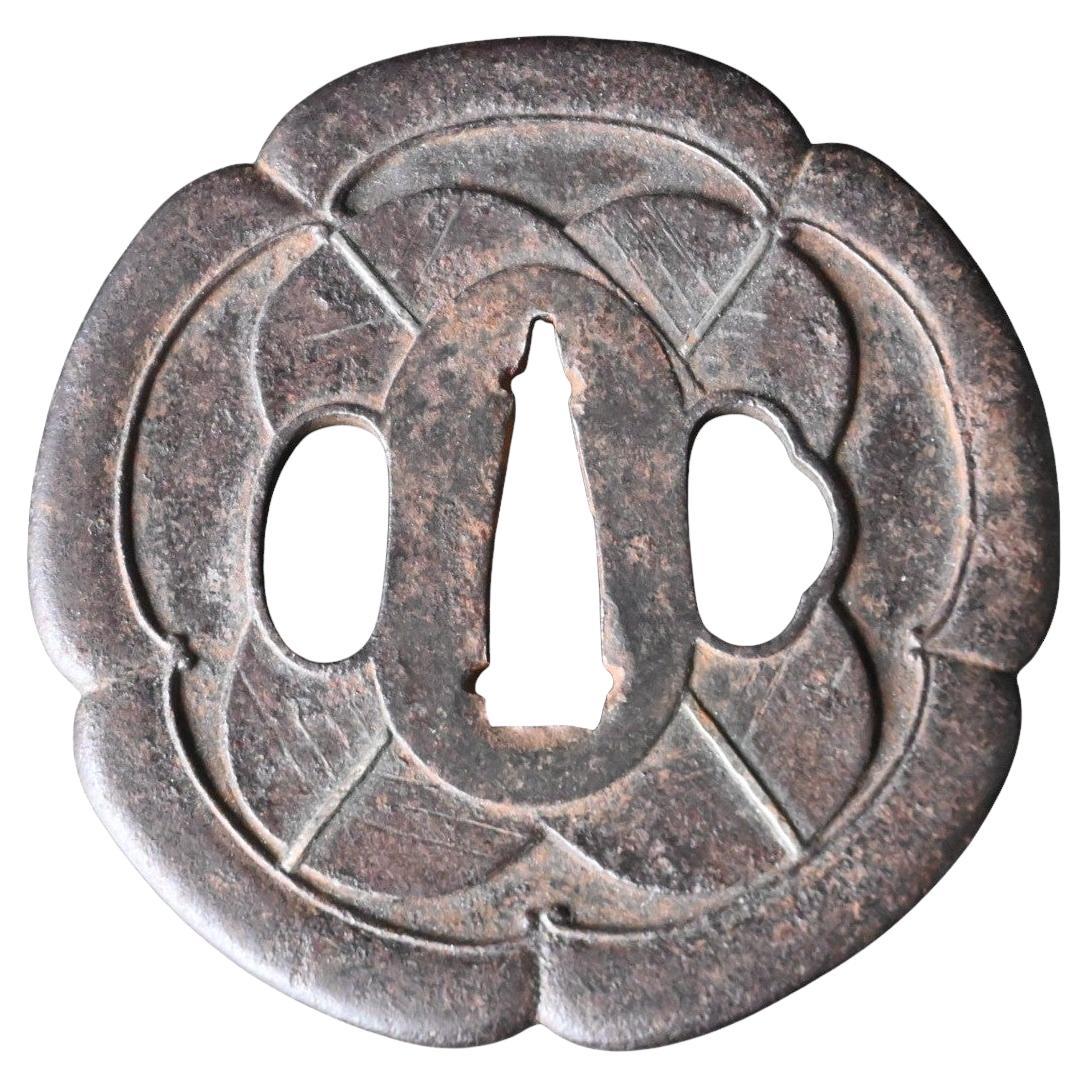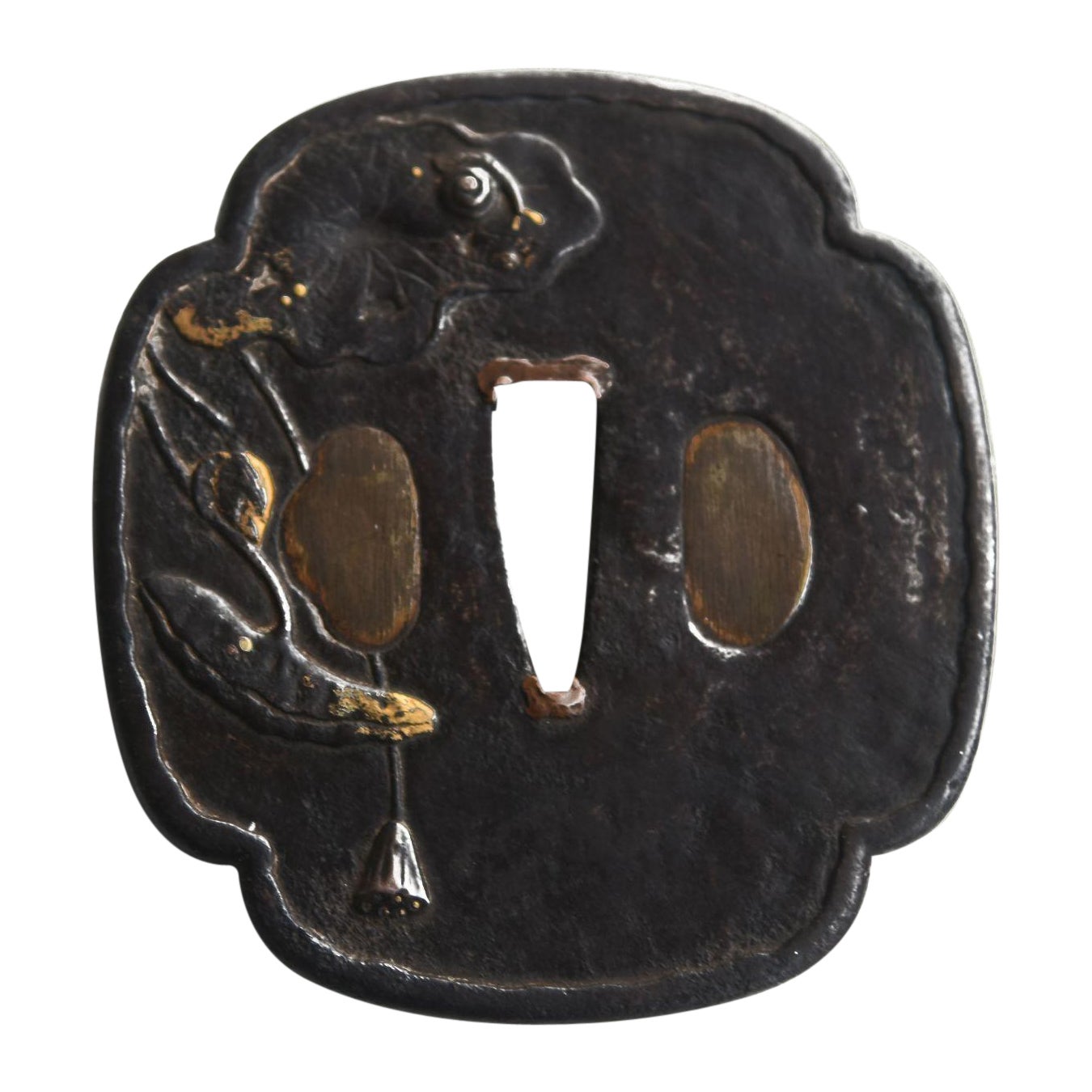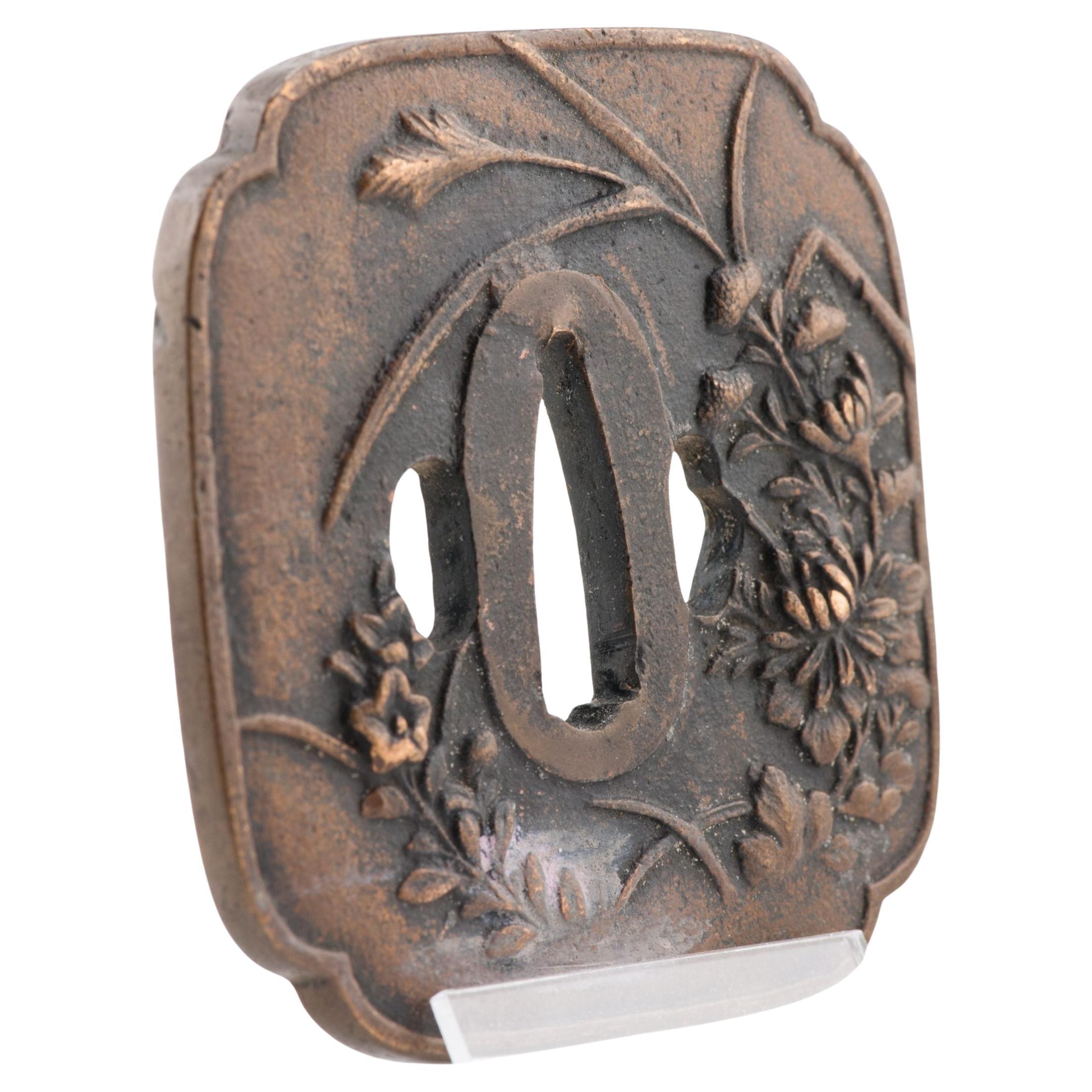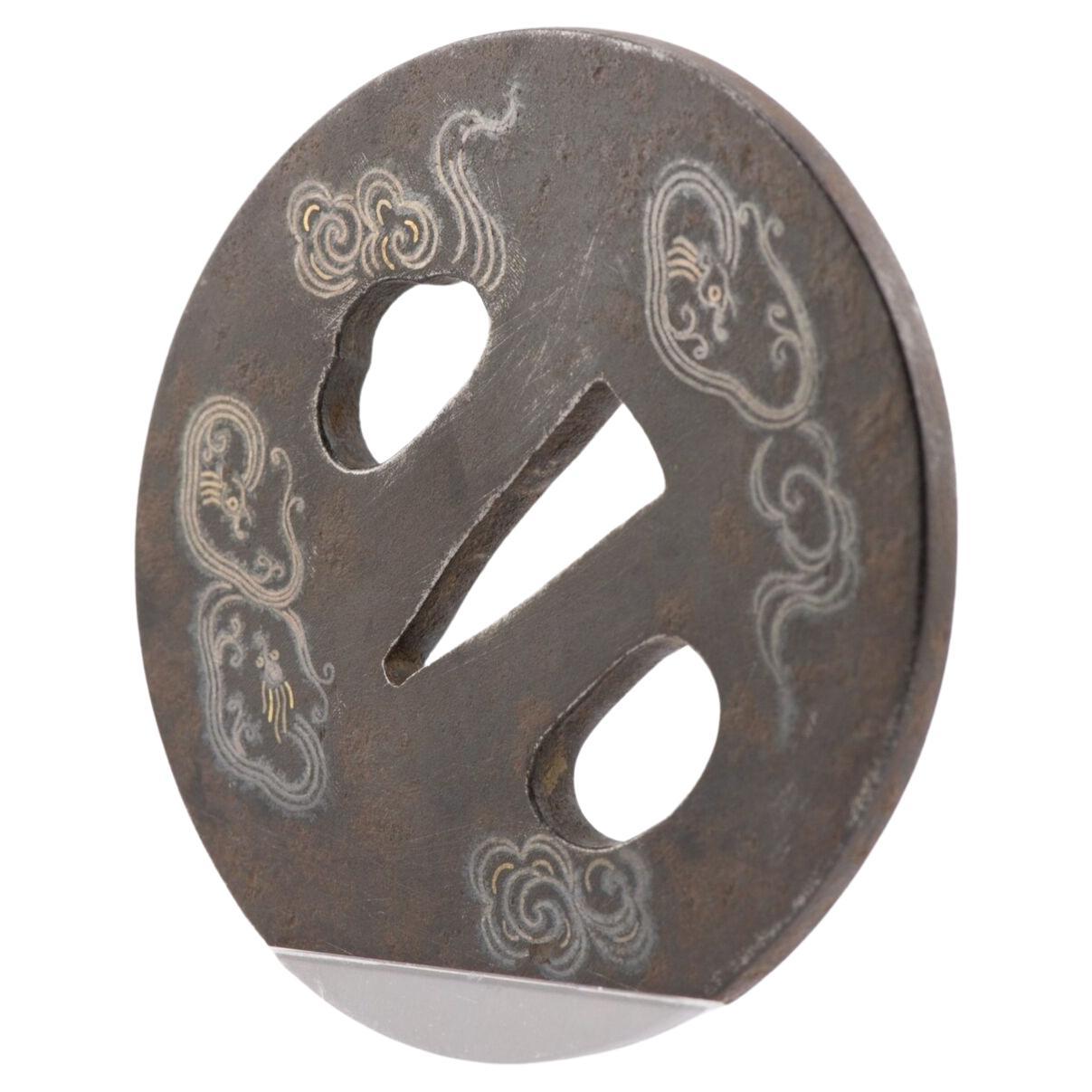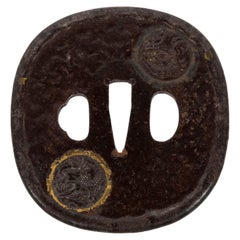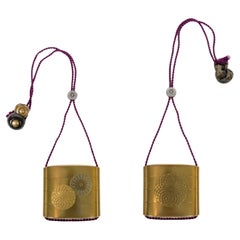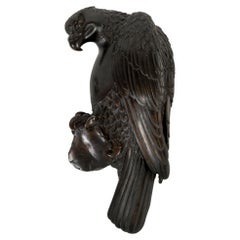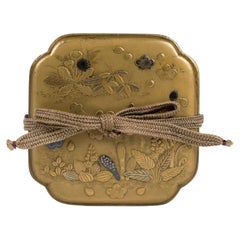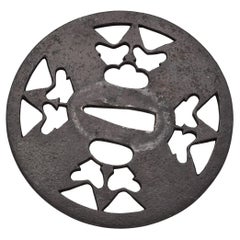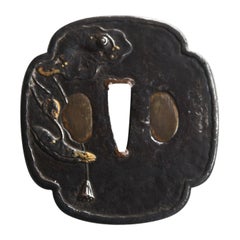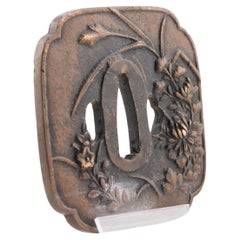Items Similar to Japan chrysanthemum tsuba
Want more images or videos?
Request additional images or videos from the seller
1 of 5
Japan chrysanthemum tsuba
$1,772.18
£1,328.36
€1,500
CA$2,434.67
A$2,718.08
CHF 1,424.23
MX$33,272
NOK 18,087.79
SEK 17,054.49
DKK 11,418.55
About the Item
Iron tsuba in the shape of a chrysanthemum (kikugata), openworked in negative with foliage and geometric patterns. Chrysanthemum shaped tsuba were quite popular in the Edo period as the flower was considered a symbol of nobility and elegance. Kikugata are often openworked in negative. This creates intricate and delicate patterns that reflect the level of sophistication and refinement of the craftsmen.
Tsuba are Japanese sword guards that have become highly decorative objects of prestige over the years. Many different subjects have been depicted on tsuba : animals, fairy tales, battle scenes or, more simply, recurring geometric motifs in Japanese cultural history (waves, nanako, kuruma). These tsuba are made from iron, shakudo shibuichi or copper, with gold and silver decoration. Before the Edo period, they were simple, mainly functional and utilitarian, protecting the hands and blocking a sword attack. With a basic and rather crude finish, they were often produced by blade smiths or armour manufacturers. It was during the Edo period, with the artistic boom generated by the stability of the country, that tsuba became works of art in their ownright, with famous schools of production.
Japan–Edo period (1603-1868)
Width: 2.9 in. (7.3 cm)–depth: 3 in. (7.7 cm)
- Dimensions:Height: 0.5 in (1.27 cm)Width: 7.3 in (18.55 cm)Depth: 7.7 in (19.56 cm)
- Materials and Techniques:
- Place of Origin:
- Period:
- Date of Manufacture:circa 1750
- Condition:
- Seller Location:PARIS, FR
- Reference Number:Seller: D-2023-11091stDibs: LU8311235340762
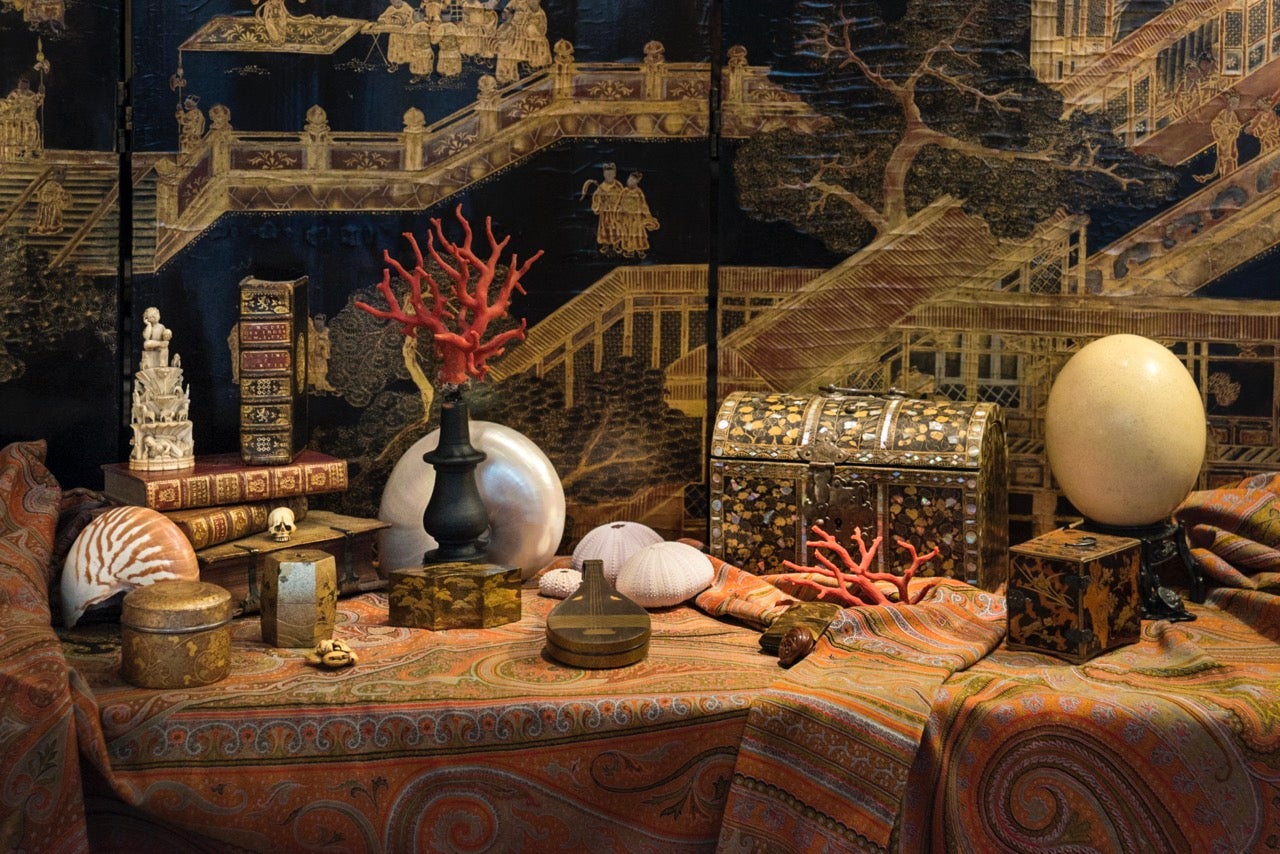
About the Seller
No Reviews Yet
Vetted Professional Seller
Every seller passes strict standards for authenticity and reliability
Established in 2013
1stDibs seller since 2023
Typical response time: Several days
- ShippingRetrieving quote...Shipping from: PARIS, France
- Return Policy
Authenticity Guarantee
In the unlikely event there’s an issue with an item’s authenticity, contact us within 1 year for a full refund. DetailsMoney-Back Guarantee
If your item is not as described, is damaged in transit, or does not arrive, contact us within 7 days for a full refund. Details24-Hour Cancellation
You have a 24-hour grace period in which to reconsider your purchase, with no questions asked.Vetted Professional Sellers
Our world-class sellers must adhere to strict standards for service and quality, maintaining the integrity of our listings.Price-Match Guarantee
If you find that a seller listed the same item for a lower price elsewhere, we’ll match it.Trusted Global Delivery
Our best-in-class carrier network provides specialized shipping options worldwide, including custom delivery.More From This Seller
View AllJapan medallions tsuba Tanaka school Edo period
Located in PARIS, FR
Ovoid-shaped (nagamarugata) iron tsuba hammered and chased with medallions. On one side, medallions of a dragon with gold highlights and a komainu (or shishi – lion dog guarding the ...
Category
Antique Mid-18th Century Japanese Metalwork
Materials
Gold, Iron
Japanese lacquered Inro chrysantemum
Located in PARIS, FR
Beautifull Inro of three compartments made in kinji lacquer with an hiro maki-e
ornament chrysanthemum flowers of gold and silver lacquer. Inside is in fundame
lacquer.
Signed by J...
Category
Antique Mid-18th Century Japanese Lacquer
Materials
Lacquer
Japanese Bronze Hawk Ikebana
Located in PARIS, FR
Bronze intended for hanging (? dô kakenanaike, « hanging bronze ») depicting a hawk, placed on a branch. The inside is hollow so a bouquet a flowers can be put inside and thus, serve...
Category
Antique Late 19th Century Japanese Metalwork
Materials
Bronze
Japanese golden kobako flowers Edo period 18th century
Located in PARIS, FR
Quadrangular kobako box decorated with flowers in gold and blue lacquer with aogai inlay. Lid and sides in fundame lacquer, underside and interio...
Category
Antique 18th Century Japanese Japonisme Lacquer
Materials
Gold
Japanese Bronze leaf and snail tray signed Ishikawa Toshio (1919-2006, 石川敏夫)
Located in PARIS, FR
Small bronze tray with green patina in the shape of a leaf with a snail on it.
Signature underneath « Toshi » (敏) Ishikawa Toshio.
Sold with its transport box
Japan, Ishikawa Toshio...
Category
Vintage 1960s Japanese Showa Metalwork
Materials
Bronze
Ikebana in bronze of an Hawk designed to display flowers hanged on the wall
Located in PARIS, FR
Bronze intentded for hanging (銅掛斜生, dô kakenanaike, « hanging bronze ») depicting a hawk, placed on a branch. The inside is hollow so a bouquet a flowers can be put inside and thus, ...
Category
Antique Late 19th Century Japanese Meiji Metalwork
Materials
Bronze
You May Also Like
Antique japanese forged iron tsuba from the Edo period
Located in Bilzen, BE
A forge iron Japanese samurai tsuba from the Edo period (1603 - 1868)
Katana tsuba 7.5 x 7.5 cm
Good condition as shown in the pictures uncleaned with its old patina
Category
Antique 18th Century Japanese Edo Metalwork
Materials
Iron
Antique Edo Period Ko-Tosho Tsuba Japanese Sword Part Dated 1846
Located in New York, NY
A circular iron plate pierce-carved Tsuba with whistles in negative silhouette. Dated from first Edo period (1615-1868).
Weight: 121.7 Grams
Material: Bronze & Copper
Measurements: ...
Category
20th Century Pendant Necklaces
Materials
Bronze, Copper
19th Century Tsuba Old Guard Of Japanese Katana
Located in Marseille, FR
19th Century Tsuba former Japanese Katana guard in bronze and gilding, diameter approximately 8 cm.
Category
Antique 19th Century Japanese Metalwork
Materials
Wrought Iron
Antique Metal Japanese Tsuba Tosogu with Floral Flowers in Landscape
Located in Amsterdam, Noord Holland
Nicely made Tsuba. The piece is unmarked. Dating to the Edo period
Provenance: Collected in the 1920's. Thence by decent
A Tsuba is a Japanese sword mountings are the various housi...
Category
Antique 19th Century Japanese Edo Ceramics
Materials
Metal, Bronze
$1,103 Sale Price
20% Off
Antique Metal Japanese Tsuba Tosogu with Chinese Coins, 19th Century
Located in Amsterdam, Noord Holland
Nicely made Tsuba. The piece is unmarked. Dating to the Edo period
Provenance: Collected in the 1920’s. Thence by decent
A Tsuba is a Japanese sword mountings are the various housi...
Category
Antique 19th Century Japanese Edo Arms, Armor and Weapons
Materials
Bronze
Antique Metal Japanese Tsuba Tosogu with Buddhist Clouds in Silver
Located in Amsterdam, Noord Holland
Nicely made Tsuba. The piece is unmarked. Dating to the Edo period
Provenance: Collected in the 1920's. Thence by decent
A Tsuba is a Japanese sword mountings are the various housi...
Category
Antique 19th Century Japanese Edo Ceramics
Materials
Metal, Bronze
$1,103 Sale Price
20% Off
More Ways To Browse
Midcentury Japanese Art
Japanese Iron
Antique Chrysanthemum
Chrysanthemum Pattern
Sword 18th Century
Antique Japanese Sword
Antique Japanese Swords
Sword Guard
Antique Japanese Armour
Tsuba Japan
Japanese Tsuba Antique
Edo Period Japanese Armor
Chinese Archaic Bronze
Bronze Okimonos
Tibetan Copper
Arts And Crafts Cloisonne
Asian Bucket
Japanese Cloisonne Charger
